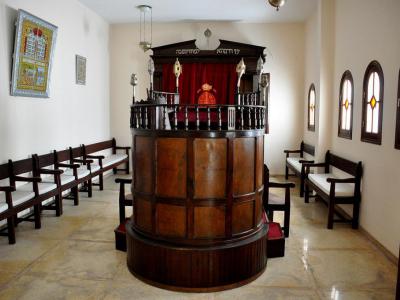
Museum of Moroccan Judaism, Casablanca
The Museum of Moroccan Judaism, located in the Oasis neighborhood of Casablanca, is the only museum dedicated to Judaism in the Arab world. Established in 1997, it is housed in a building that dates back to 1948, originally serving as a Jewish orphanage for up to 160 children. The museum underwent significant renovations in 2013 to support its expanded role.
The foundation of the museum was driven by Simon Levy, a notable former professor at the University of Rabat and a fervent advocate for Moroccan Jewish culture and human rights. Levy, who lived from 1934 to 2011, played a pivotal role during the colonial period and the reign of King Hassan II, dedicating his later years to preserving Jewish heritage in Morocco.
The museum’s collection is rich and varied, featuring significant Jewish artifacts such as a bimah from the Beni-Issakhar Synagogue in Casablanca, dating back to around 1944, along with mezuzahs, and Hanukiah menorahs. Additionally, it showcases Berber history, including traditional costumes, jewelry, and Fatima pendants, highlighting the intertwined histories of Jewish and Berber communities in Morocco.
One of the museum's intriguing exhibits is a recreated jewelry-making shop, which includes the original workbench and tools of a Moroccan Jew named Saul Cohen. This exhibit provides insight into the craftsmanship and cultural contributions of Moroccan Jews.
The museum’s architecture spans 700 square meters and features a large multipurpose room used for displaying art by Jewish Moroccans, including paintings, photographs, and sculptures. Three other exhibit rooms focus on religious practices, family life, and recreations of Moroccan synagogues, offering visitors a comprehensive view of Jewish life in Morocco.
In 2019, the museum's collection expanded significantly thanks to a generous donation from French Moroccan opera singer David Serero, who contributed a large portion of his Moroccan Judaica art collection, marking the largest donation of Judaica artifacts ever received by a Moroccan museum.
The foundation of the museum was driven by Simon Levy, a notable former professor at the University of Rabat and a fervent advocate for Moroccan Jewish culture and human rights. Levy, who lived from 1934 to 2011, played a pivotal role during the colonial period and the reign of King Hassan II, dedicating his later years to preserving Jewish heritage in Morocco.
The museum’s collection is rich and varied, featuring significant Jewish artifacts such as a bimah from the Beni-Issakhar Synagogue in Casablanca, dating back to around 1944, along with mezuzahs, and Hanukiah menorahs. Additionally, it showcases Berber history, including traditional costumes, jewelry, and Fatima pendants, highlighting the intertwined histories of Jewish and Berber communities in Morocco.
One of the museum's intriguing exhibits is a recreated jewelry-making shop, which includes the original workbench and tools of a Moroccan Jew named Saul Cohen. This exhibit provides insight into the craftsmanship and cultural contributions of Moroccan Jews.
The museum’s architecture spans 700 square meters and features a large multipurpose room used for displaying art by Jewish Moroccans, including paintings, photographs, and sculptures. Three other exhibit rooms focus on religious practices, family life, and recreations of Moroccan synagogues, offering visitors a comprehensive view of Jewish life in Morocco.
In 2019, the museum's collection expanded significantly thanks to a generous donation from French Moroccan opera singer David Serero, who contributed a large portion of his Moroccan Judaica art collection, marking the largest donation of Judaica artifacts ever received by a Moroccan museum.
Want to visit this sight? Check out these Self-Guided Walking Tours in Casablanca. Alternatively, you can download the mobile app "GPSmyCity: Walks in 1K+ Cities" from Apple App Store or Google Play Store. The app turns your mobile device to a personal tour guide and it works offline, so no data plan is needed when traveling abroad.
Museum of Moroccan Judaism on Map






Sight Name: Museum of Moroccan Judaism
Sight Location: Casablanca, Morocco (See walking tours in Casablanca)
Sight Type: Museum/Gallery
Sight Location: Casablanca, Morocco (See walking tours in Casablanca)
Sight Type: Museum/Gallery
Walking Tours in Casablanca, Morocco
Create Your Own Walk in Casablanca
Creating your own self-guided walk in Casablanca is easy and fun. Choose the city attractions that you want to see and a walk route map will be created just for you. You can even set your hotel as the start point of the walk.
Casablanca Introduction Walking Tour
Leo Africanus, an Andalusi diplomat and travel writer of the 16th century, declared the Moroccan city of Casablanca to be the site of the ancient Berber city of Anfa, founded in 744 AD. Anfa was a city of the Berber kingdom of Barghawata. The independence of the kingdom ended in 1068 when it was conquered by the Arab Almoravids.
The Almoravid dynasty in turn was displaced by the Berber Merinids... view more
Tour Duration: 2 Hour(s)
Travel Distance: 3.9 Km or 2.4 Miles
The Almoravid dynasty in turn was displaced by the Berber Merinids... view more
Tour Duration: 2 Hour(s)
Travel Distance: 3.9 Km or 2.4 Miles
Casablanca Old Town Walking Tour
Although the Old Town (Medina) of Casablanca is not as ancient as that of the imperial cities like Fez or Marrakech, it is well worth seeing all the same. The historic heart of the city, rather modest in size – measuring some 50 hectares, is made up of three parts: the Medina proper; the Jewish quarter, or Mellah, with the Ettedgui Synagogue in it; and the popular quarter called Tnaker.
... view more
Tour Duration: 1 Hour(s)
Travel Distance: 1.9 Km or 1.2 Miles
... view more
Tour Duration: 1 Hour(s)
Travel Distance: 1.9 Km or 1.2 Miles
Useful Travel Guides for Planning Your Trip
Casablanca: 15 Shopping Ideas for Travelers
What's more to Casablanca than the famous 1940s movie starring Humphrey Bogart and Ingrid Bergman? Although "much water has flown under the bridge" since, there are things in Morocco still not fading away with time, just as those desert colors. Here are some of the items worth noting...



